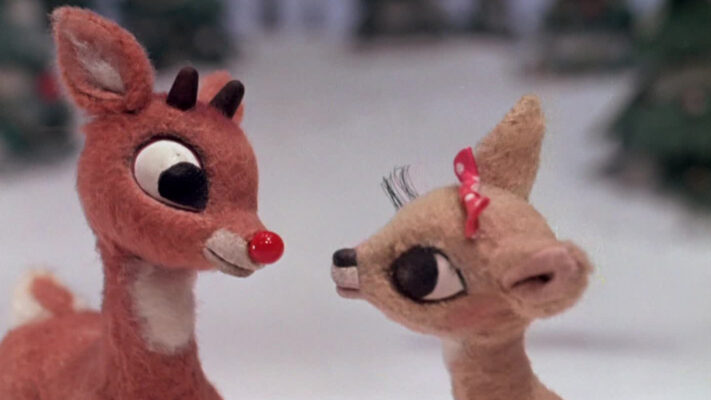The beloved story of Rudolph the Red-Nosed Reindeer has captivated generations since its debut, but many fans are curious to know who played Rudolph the Red Nosed Reindeer in various adaptations. In this article, Alibaytoon Store explore the various actors and voice talents who have played Rudolph the Red-Nosed Reindeer, focusing on some of the most notable adaptations over the years, including the classic 1964 stop-motion TV special and other important portrayals.

Who Played Rudolph the Red Nosed Reindeer? The Origins of Rudolph’s Fame
Before delving into the actors who played Rudolph, it’s important to understand how this character came to be. The story of Rudolph originated in 1939 as a promotional booklet created by Robert L. May for the Montgomery Ward department store. The story introduced Rudolph as a reindeer with a glowing red nose, who was initially mocked for being different, only to save Christmas by leading Santa’s sleigh through a foggy night.

It wasn’t until 1949, when Johnny Marks, May’s brother-in-law, turned the story into the famous song “Rudolph the Red-Nosed Reindeer,” that the character became a cultural icon. The song, performed by country singer Gene Autry, topped the charts and paved the way for numerous adaptations, including films, television specials, and live performances.
1964: The Iconic Rankin/Bass TV Special
One of the most beloved portrayals of Rudolph the Red-Nosed Reindeer comes from the 1964 stop-motion TV special produced by Rankin/Bass Productions. This holiday classic has aired on television every Christmas season for decades, becoming a staple of holiday programming.
In this adaptation, Rudolph was voiced by Canadian actress Billie Mae Richards. Despite being an adult woman, Richards provided the voice of the young male reindeer, delivering a performance that has since become synonymous with the character. Her high-pitched, youthful voice perfectly captured Rudolph’s innocence and determination, making her portrayal one of the most memorable in Rudolph’s history.
Richards had a long and distinguished career in voice acting, but her role as Rudolph is undoubtedly her most famous. She voiced the character in subsequent Rankin/Bass specials as well, including Rudolph’s Shiny New Year (1976) and Rudolph and Frosty’s Christmas in July (1979). Her portrayal of Rudolph in the original 1964 special remains a cornerstone of holiday television and has left a lasting legacy in popular culture.
Gene Autry: The Voice Behind the Song
Although Gene Autry didn’t voice Rudolph in a film or television adaptation, it’s important to mention his role in bringing the character to prominence through music. Autry’s 1949 recording of “Rudolph the Red-Nosed Reindeer” became a huge hit, cementing Rudolph as a key figure in Christmas celebrations.

Autry was one of the first to make Rudolph a household name, and while he didn’t technically “play” the character, his performance of the song has become so iconic that many people associate him with the reindeer’s voice. His warm, country-style rendition of the song brought the story to life for millions of listeners, helping to establish Rudolph as a beloved figure in holiday lore.
Other Notable Portrayals of Rudolph
While the 1964 TV special remains the most famous adaptation of Rudolph’s story, there have been numerous other portrayals of the character over the years, each contributing to the ongoing legacy of the red-nosed reindeer.
1998: Rudolph the Red-Nosed Reindeer: The Movie
In 1998, a full-length animated film titled Rudolph the Red-Nosed Reindeer: The Movie was released, offering a new take on the classic story. In this adaptation, Rudolph was voiced by actress Kathleen Barr, another Canadian talent known for her extensive work in animation.
Barr’s portrayal of Rudolph brought a fresh, modern take on the character while staying true to the themes of the original story. Her voice performance helped to reintroduce Rudolph to a new generation of children, ensuring that the story continued to resonate with young audiences.
2001: Rudolph the Red-Nosed Reindeer and the Island of Misfit Toys
In 2001, another animated special featuring Rudolph was released, titled Rudolph the Red-Nosed Reindeer and the Island of Misfit Toys. In this CGI adaptation, Rudolph was voiced by Canadian voice actor Kathleen Barr once again, reprising her role from the 1998 film. This adaptation continued the story of Rudolph’s adventures after the events of the original tale, introducing new characters and challenges for the red-nosed reindeer.
Stage Productions and Live-Action Performances
Beyond film and television, Rudolph has also been portrayed in stage productions and live-action performances. Various holiday stage shows have featured actors in Rudolph costumes, bringing the character to life in front of live audiences. While these portrayals don’t always involve voice acting, they are an important part of Rudolph’s cultural legacy, particularly in bringing the story to young children and families in an interactive, festive setting.
One such popular stage production is Rudolph the Red-Nosed Reindeer: The Musical, which tours during the holiday season and features a live-action portrayal of Rudolph, complete with singing and dancing. These stage adaptations allow fans to experience Rudolph’s story in a new way, bringing the character to life in a festive and joyful atmosphere.
Why Female Voice Actors Often Play Male Characters
It may come as a surprise to some that many of the actors who have voiced Rudolph are women, particularly Billie Mae Richards and Kathleen Barr. This practice is quite common in the world of animation, where female voice actors often play young male characters.

One reason for this is that women’s voices tend to have a higher pitch, which is ideal for portraying the voices of young boys or adolescent characters. Additionally, women’s voices can maintain a consistent youthful tone over the years, whereas a male actor’s voice might change or deepen with age. This is why many beloved male characters, such as Bart Simpson (voiced by Nancy Cartwright) and Ash Ketchum from Pokémon (voiced by Veronica Taylor and later Sarah Natochenny), are voiced by women.
In the case of Rudolph, having a female voice actor like Billie Mae Richards or Kathleen Barr helped to emphasize the character’s youth, vulnerability, and innocence, key traits that are central to Rudolph’s story.
The Legacy of Rudolph’s Voice Actors
The various actors and actresses who have played Rudolph the Red-Nosed Reindeer have all contributed to the character’s enduring appeal. From Billie Mae Richards’ iconic performance in the 1964 TV special to Kathleen Barr’s modern take on the character in the 1998 film, each portrayal has added a unique layer to Rudolph’s character, ensuring that his story continues to resonate with new generations of fans.
These voice actors have not only brought Rudolph to life but have also helped to reinforce the themes of acceptance, kindness, and courage that are central to his story. Through their performances, Rudolph remains a symbol of hope and perseverance, a character who teaches us all the value of embracing our differences and celebrating what makes us unique.
So, who played Rudolph the Red Nosed Reindeer? Over the years, several talented actors and voice performers have brought this beloved character to life. From Billie Mae Richards’ unforgettable voice in the 1964 Rankin/Bass TV special to Kathleen Barr’s portrayal in modern animated films, each actor has helped to cement Rudolph’s place as one of the most iconic figures in Christmas folklore.
As you celebrate the holiday season this year, take a moment to appreciate the talented performers who have given Rudolph his voice and made him the cherished character we know and love today.
Don’t forget to celebrate in style! Get your Rudolph the Red-Nosed Reindeer T-shirts at Alibaytoon Store and embrace the holiday spirit with this timeless Christmas icon.
